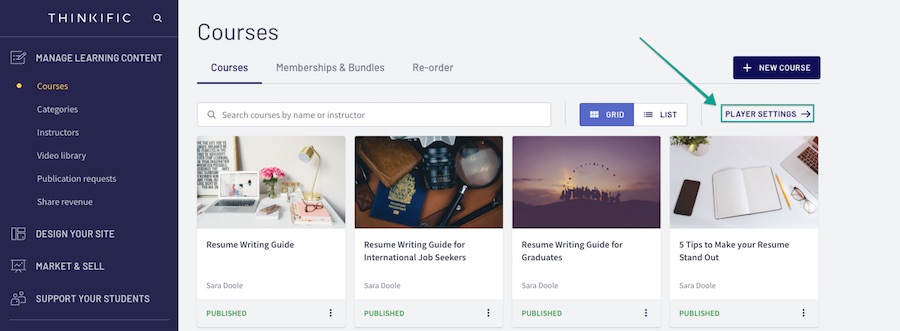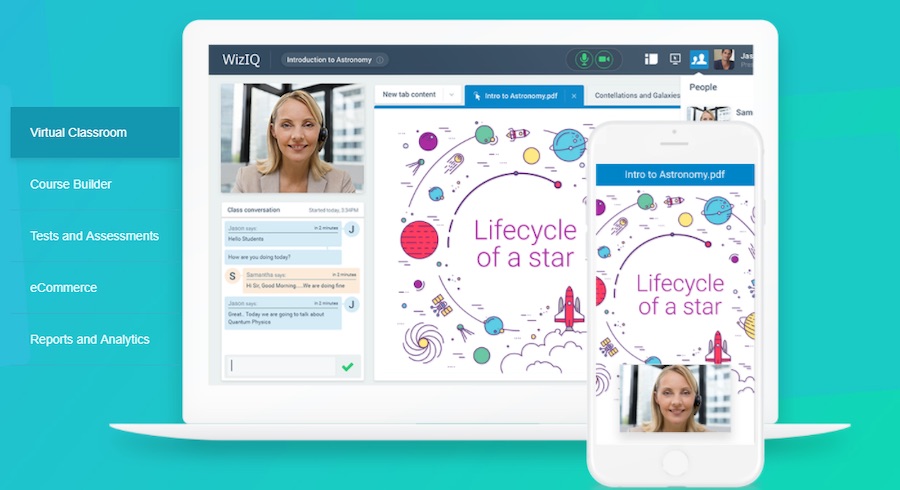Online Education and Course Platforms
I have been researching online education platforms for some time now, and I have been working on making a list of topics that I believe are missing. In this post, I will share the information and observations I've gathered throughout this process.
In this article, I wanted to discuss the process of creating and publishing online training content, as well as emphasize the importance of planning and considering content delivery. I also provided a list of online education platforms that educators can use to share their content, including those where they can publish their own courses as well as popular Massive Open Online Course (MOOC) platforms. I also differentiated between course platforms and learning management systems and provided information on the features and pricing of each platform. Overall, the article serves as a useful guide for educators who wish to share their knowledge and monetize their expertise through online training.
Planning and Delivery Considerations for Online Training Content: Choosing the Right Platform
Due to the additional time and technical requirements, preparing and publishing online training content requires much more planning than producing YouTube videos. Additionally, it is essential to consider how the content will be delivered. While Udemy1, a well-known solution, is often considered, many educators find it less profitable. In my conversations with educators, they prefer platforms with the necessary features and accessibility, such as payment gateways and pricing policies. For example, a platform may have great functionality but lack a suitable payment gateway or pricing policy. With this information, it is possible to create a list of online education platforms suitable for sharing content.
I have listed the platforms under two main categories. The first list includes platforms where you can both publish your own courses and enroll in existing courses. The second list includes solutions where it may be difficult or impossible to publish your own courses, but you can easily benefit from the courses offered.
Before moving on to the lists, it's worth noting the difference between course platforms and Learning Management Systems (LMS). Course platforms, as you can see from the options below, are focused on course creation. Furthermore, they frequently provide the option to integrate with other platforms where courses can be featured. The course owner is responsible for course promotion, pricing, and communication with participants on most course platforms. In contrast, educational platforms are typically centralized, and the interaction process is governed by a centralized mechanism. For instance, course recommendations, promotions, pricing, and so on. As a result, you can think of online course platforms as LMS derivatives.
Online Course Platforms Where You Can Publish Your Own Courses
The platforms are alphabetically sorted. First, I will start with services that we can easily add and introduce to the training we have personally prepared. But, of course, this list will also be useful for readers who reach the educational objectives. For this purpose, I also recommend that you look at the Top Educational Platforms[^others] title.

Academy of Mine
Academy of Mine includes free platform support, step-by-step guidance, content/data transfer assistance, core courses, sales page creation and customizations2, rather than individual training. However, it is possible for them to pay for it3.

Kajabi
Kajabi handles the educational process in a different way. Content is treated more like a product (course, subscription, digital product, etc.) under the Products feature. Products created with Websites can be customized and presented. Additionally, the website can be easily associated with different platforms through integrations. Integration processes can also be used in marketing and sales operations with Pipelines. The Basic, Growth and Pro membership options vary depending on the number of products, pipelines, unlimited landing pages, marketing emails, contacts, websites, etc.4.

LearnDash
LearnDash is a WordPress plugin. The plugin is managed with the Basic,Pro and Plus packages, and turns the website into an LMS. The packages are priced according to the number of site licenses 5. With the package, features such as unlimited courses, users, content protection, quizzes, forums, integrations, etc. become available 6."

Learnworlds
Learnworlds offers features such as page builder, unlimited courses, community management, coupon creation, integrations, membership/subscriptions, unlimited landing pages, certificate creation, live classes, question bank, etc. under the Starter, Pro Trainer, Learning Center and High Volume & Corporate packages7. You can quickly sign up for the service by providing an email address and take advantage of the Starter features during the 30-day trial period.

Podia
Podia offers various packages such as Mover, Shaker, and Creator, providing features such as courses, digital downloads, webinars, email marketing, messaging, unlimited products, customers, email sends, and file hosting8. The Shaker package is required for membership/subscriptions, zoom integration, blog, offline sales, and code customizations. You can enjoy many features during the 14-day trial period.

Ruzuku
Ruzuku offers the Bootstrapper, Up-and-Comer, and University membership options and focuses on corporate training. The Bootstrapper starting package includes unlimited courses and students, unlimited space usage, and coupon creation, while other packages expand to include multi-site management, membership/subscription options, and more9. During the 14-day trial period, you can benefit from the Bootstrapper features. This education platform has a relatively basic management panel compared to other alternatives, and customizations and integrations can be limited compared to other alternatives.

Shaw Academy
Shaw Academy has over 100 courses, over 3,000 hours of education content, and has 12 million students since its founding in 2012. The platform provides certified education in certain areas with its own instructors10. You can join and participate in all courses for four weeks free of charge by becoming a member (you need to provide a credit card). However, there is no application process for becoming an instructor.

SkillShare
Founded in 2010, Skillshare is one of today's popular learning platforms with courses in various areas of expertise11. Courses on advertising, design, personal development, and more, created by experts, can be accessed through a specific subscription fee12. Additionally, you can offer your own courses through the platform as a Teacher and manage them via video streaming and descriptions13. The platform has a more basic approach compared to other course/learning platforms, and you can also share projects/resources through your profile page.

Teachable
Teachable (formerly known as Fedora) has a history dating back to 2013. The platform has reached a volume of $500 million through more than 100,000 instructors until 2020. With the demo membership, you can perform many operations within the framework of the standard membership14. However, you need to choose one of the paid membership options (Basic, Pro, Business) specified for publishing education. Unlike many other education platforms, it is also possible to offer private lessons in addition to courses. Pricing and customization can also be done separately for each option. Business also offers you the opportunity to customize pages with liquid15.
The platform prioritizes the education creation process and enables the instructor to provide the promotion and community management of the courses themselves. The courses can be listed and presented like a separate website (even with custom design and domain name usage)4.
If you plan to create courses regularly and also offer one-on-one lessons, Teachable can be one of the options you can consider.

Thinkific
Thinkific is one of the platforms I enjoyed reviewing. The platform has over 50,000 instructors and students from various countries, and over 75 million learning hours have been accessed. After registering, it's quite easy to create a course plan16. The platform offers private and hidden courses, prerequisite lessons, multiple instructors, cohorts, timed content, and membership pages, among other features. Additionally, the platform supports many payment methods. If you plan to take the course creation process as a separate income stream, Thinkific is a suitable option. For more information on the process, you can check the "Manage Learning Content"17 section.
The platform offers free access to basic features for testing purposes. However, the most basic package that can be used for publishing courses is the BASIC package. You can check the Pricing18 page for details on packages, pricing, and other information.

WizIQ
For WizIQ, after registration, you need to share information such as the number of classes (depending on the number of lessons), average number of participants, your planning, website integration, extra features, online sales, and other details via the email sent to you. When your application is approved, you will be provided with access information19. No fee information is shared for membership. All detailed information and subsequent operations (including the trial period) will be available after the initial review. Currently, the system is being used by over 5,000 organizations, and more than 400,000 educators are teaching over 4 million students through virtual classrooms.
Other Popular Online Learning Platforms
Below, I have also included some commonly used and well-known education platforms that I think are useful for information. These education platforms (Udemy is included in this definition) are characterized as massive open online course (MOOC20) platforms21. I couldn't title this article online education platforms and not mention them. In order to publish an education on these education platforms, you need to meet certain requirements. Therefore, they need to be evaluated differently from the options above.

Udemy
Udemy is one of the well-known and preferred online education platforms. Almost everyone in my surroundings has a Udemy account and has taken at least one course. I have taken 69 courses on Udemy, completing 16 of them22.
As an educator, I started planning and uploading videos a long time ago, but I could not continue. The educators I talked about also generally spoke about the fact that earnings from Udemy were quite low. After these feedback, I did not continue the process and temporarily tried to gain experience at least in the video production process by posting videos via YouTube.
Udemy23 is an online training application that dates back to 2007, but was actively launched in early 2010 by Bali, Oktay Era and Gagan Biani. Actively developed as a product in May 2010, Udemy takes its first steps in a few months with 1,000 instructors and about 2,000 courses. With approximately 10,000 registered users, the founders who are in the funding tour initiative will bring the platform to the present day by raising $1 million in funding by August.
At present, Udemy shares information that it has more than 30 million students and 50,000 teachers in more than 60 languages.The educational platform contains more than 245 million course records, students and instructors from more than 190 countries, and a large percentage of its users are outside the U.S23.
When you are involved in the system as a trainer, you also need to plan areas such as student identification, course structure, course opening page, pricing, promotion. Because based on the information here, the system conducts the promotion and promotion process of education itself. The list price that students will see in other currencies is also presented by calculating through the system using the price scale matrix according to the corresponding scale.
If you want to publish your course for free, the total length of your video content should not exceed 2 hours.
In general, the information I gathered was that the training needs to be offered to a mass audience and presented to the created audience. At this stage, it is not possible for me to share my direct observations as I do not have training that I can test and compare. However, if I have the opportunity to observe the process with alternative training, I will be happy to update this article.

FutureLearn
FutureLearn24 is an online training platform that began in December 2012 and offers access to training through membership options. In cooperation with universities and various organizations, platform short courses, micro credentials, and programs are offered, such as online professional or academic accreditation courses. The platform has more than 440,000 registered users from over 190 countries. You must apply for a partnership to publish your training through FutureLearn. If you meet the specified criteria25.

Udacity
Udacity26 is an educational platform created in 2011 by Stanford University to offer computer science courses for free. With 160,000 students enrolling in Introduction to Artificial Intelligence, the platform crossed a significant threshold, with 90,000 students enrolled in its first two classes as of March 2012. Udacity, which was officially announced at the 2012 Digital Life Design conference with the growing interest in content evolving from university-style courses to vocational courses for professionals, currently has more than 160,000 students in more than 190 countries27.
To publish a tutorial, you must prove your expertise and commit to fulfilling the requirements28 specified by Udacity.

Coursera
Coursera29 is an online course provider founded in 2012 by Stanford University computer science professors Andrew Ng and Daphne Koller. The courses are mainly offered in collaboration with universities and other organizations. The courses are also validated by many organizations with specialized certificates and degrees (Course Certificate, Professional Certificate, MasterTrack™ Certificate, diploma)30.
There are currently 5,363 courses created by 224 partners from 55 countries22. The partners include organizations such as Amazon Web Services, Atlassian, Autodesk, Cisco Facebook, GitLab, Google, and many educational institutions such as Columbia University, Arizona State University, Duke University, and Eindhoven University of Technology31.
To publish courses on Coursera, you need to be affiliated with the relevant organizations. This ensures that the courses are above a certain level.

edX
edX is a non-profit education platform, the first steps of which were taken by Harvard and MIT. The main goal of the platform is to offer university-level courses in many disciplines to students around the world. To this end, research on learning is conducted through the system and the platform is constantly being improved32 based on how people use the platform. More than 150 schools, non-profit organizations and companies offer or plan to offer courses on the edX website33. Over 2,200 courses are defined in the system and more than 34 million students have benefited from these courses.
edX collaborates with various organizations globally, including academic institutions such as major research universities, polytechnic and liberal arts colleges, non-profit organizations, national governments, civil society organizations (NGOs), and multinational companies for the MicroMasters TM program and other educational programs and related services. Only those who are associated with these organizations can be added to the training.
Of course, all options are not just these34 35, but you should also remember options such as treehouse and datacamp, which are not mentioned above and are focused on specific topics.
These are my notes for both those who are planning to provide education and those who are doing research on online education platforms. You can share the topics you think are missing and your suggestions as comments. You can follow Podia, LearnWorlds, Thinkific, Teachable and Kajabi and other web analytics related articles on LMS. Apart from that, the platform I'm considering for publishing tutorials seems to be Podia.
Conclusion
In conclusion, creating and publishing online training content requires careful planning and consideration of the delivery platform. While Udemy is a well-known option, many educators find it less profitable and prefer platforms with suitable payment gateways and pricing policies. There are various online course platforms where you can publish your own courses, such as Academy of Mine, Kajabi, LearnDash, Learnworlds, Podia, Ruzuku, Shaw Academy, SkillShare, Teachable, and Thinkific. These platforms offer different features and pricing options. Additionally, there are popular online learning platforms, such as FutureLearn, Udacity, Coursera, and edX, that offer massive open online courses (MOOC) but require affiliation with relevant organizations to publish courses.
- Udemy. Wikipedia ↩
- Why Us. Academy of Mine ↩
- Pricing & Plan Features. Academy of Mine ↩
- Baidhurya Mani. (2020). Kajabi vs Teachable: Which is Best for Your Online Courses? ↩ ↩
- Pricing. Learndash ↩
- Add-ons. Learndash ↩
- Pricing. LearnWorlds ↩
- Pricing. Podia ↩
- Plans. Ruzuku ↩
- About. Shaw Academy ↩
- SkillShare. Wikipedia ↩
- Premium. SkillShare ↩
- Teach. SkillShare ↩
- Features. Teachable ↩
- Pricing. Teachable ↩
- Features. Thinkific ↩
- Manage Learning Content. Thinkific ↩
- Pricing. Thinkific ↩
- Online Course Creation. WizIQ ↩
- Massive open online course. Wikipedia ↩
- EduTechReview. (2017). The 9 best MOOCs platforms ↩
- 16/11/2020 tarihindeki bilgiler temel alınmıştır. ↩ ↩
- About Us. Udemy ↩ ↩
- FutureLearn. Wikipedia ↩
- Become a FutureLearn partner. FutureLearn ↩
- Udacity. Wikipedia ↩
- Build with Udacity ↩
- About Us. Udacity ↩
- About. Coursera ↩
- Coursera. Wikipedia ↩
- Exceptional Educators and Partners ↩
- edX. Wikipedia ↩
- Schools and Partners. edX ↩
- Jeff Cobb. (2020). 15+ Platforms to Create and Sell Online Courses (and Counting) ↩
- Will Dalton, Brian Turner. (2020). Best online learning platforms of 2020: LMS and VLE for education ↩